INTRODUCTION
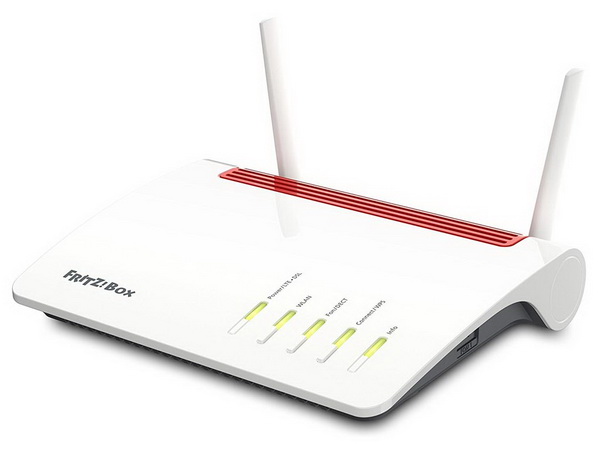
I still remember the very first time i logged into the world wide web back in 1994 via a 14.4kbit/s dial-up modem (i even remember the very first software i used to communicate with people living all over the world, KALI). So, from that going all the way to the 220Mbit/s VDSL connection that i have right now, well I'm sure you get my point. Unfortunately, not every network peripheral manufacturer out there supports VDSL connectivity today but the ones that do have released some very interesting models with supported speeds of up to 300Mbit/s. Why stop there however? Why not also add LTE functionality to a regular VDSL modem/router, that way if your landline fails for whatever reason, you can still be on the internet via the SIM card (internet redundancy). Well, this is exactly what AVM thought about and the end result is no other than the FRITZ!Box 6890 LTE (V2) which is also what I've been testing for quite a while now.
AVM is one of Europe's leading manufacturers of products for broadband connections and the digital home. FRITZ! brand products are easy to use for everyone. They enable fast internet access, easy networking, convenient telephony and versatile Smart Home applications. The FRITZ!OS software regularly offers new features and keeps all FRITZ! products up-to-date and secure. Since starting out in Berlin in 1986, AVM' has focused on developing innovative products in-house. In 2020 the Berlin-based communications specialist had 840 employees and generated a turnover of 580 million euros.
As with the FRITZ!Box 6850 which i reviewed a few weeks back (review here) the 6890 is also an LTE model based on the same 4G broadband cellular network technology which has been around for roughly a decade now. AVM will certainly update all their LTE lines with 5G connectivity soon but as i mentioned in my previous review it may take a while for compatibility issues and real world performance to reach optimal results. As for the FRITZ!Box 6890 well it combines VDSL/DSL and 4G LTE/3G UMTS/HSPA+ connectivity (fallback support - up to 300Mbit/s) with AC2533 dual-band Wi-Fi (5GHz 802.11ac at 1733bps and 2.4GHz 802.11n at 800Mbps with Multi-User MIMO support) so it's certainly a step up compared to the 6850 model. Of course, it also packs many features including an integrated DECT base station (with support for up to 6 cordless handsets), 2 detachable high-gain antennas, IP telephony, Media Server and NAS functionality (with remote access), WPS easy connect, green mode for decreased power consumption (USB & Wi-Fi), support for Smart Home Devices (either via FRITZ! devices or third-party devices with support for the DECT ULE/HAN FUN standard) and of course for AVM's MESH function. Under the hood of the FRITZ!Box 6890 LTE AVM has placed the AnyWan GRX550 dual-core network CPU together with the QCA9984 Wave-2 802.11ac 5GHz dual-band 4x4 (1733Mbit/s peak speed - fully supports Multi-User MIMO with both 160MHz and 80+80MHz channels) and QCA9985 802.11n 2.4GHz (800Mbit/s peak speed) radios by Qualcomm, 512MB DDR3L SDRAM by NANYA and 512MB flash memory by Macronix. As for available connectors the FRITZ!Box 6890 LTE has a single USB 3.0 port, Mini SIM slot, both analog and digital telephony ports, 4 gigabit Ethernet ports, WAN port and the VDSL/DSL port.
SPECIFICATIONS AND FEATURES

PACKAGING AND CONTENTS
As with every box to date a product picture is placed at the front right next to the main product features and beneath the FRITZ! logo.
A few words about the product are placed on the right side of the box just under 2 stickers with its serial numbers and barcodes.
Some of the benefits of owning this modem/router are printed on the left side.
The main product features are also listed and explained at the rear of the box in 6 languages right under yet another product picture used to showcase it’s available connectors.
As always, the device is protected by several pieces of cardboard.
Contained inside the box are the FRITZ!Box 6890 LTE with its power adapter, two detachable antennas, 1.5 meter long flat Ethernet cable, AVM product catalog, WiFi network card and a very detailed quick guide.
THE FRITZ!BOX 6890 LTE V2 EXTERIOR
Just like the 6850 model the 6890 shares the same plastic enclosure which this time measures just 250mm in length, 185mm in width and 48mm in height.
Here you can see how the FRITZ!Box 6890 compares to the 6850 model.
At the top of the modem, we find 3 buttons and 5 activity LEDs (power-mobile/wireless Lan/DECT phone/WPS/info).
Most of the rear top is perforated to allow hot air to exit the interior.

At the rear we find two Antenna ports, DSL port, two FON ports, WAN Gigabit port, 4 Gigabit LAN ports and the mini SIM slot.
The bottom is almost entirely perforated and has four small rubber feet and two holes for wall mounting.
Finally to use the FRITZ!Box 6890 (at least its LTE and Wi-Fi) you will need to attach both high-gain antennas.
THE FRITZ!BOX 6890 LTE V2 INTERIOR
The moment you access the interior you’ll notice a large black heatsink.
Under that black heatsink AVM has placed the AnyWan GRX550 dual-core network CPU with the 512MB DDR3L SDRAM by NANYA and the 512MB flash memory by Macronix (there’s also a 4th module here which I couldn’t identify in time).
Other components include the L830-EB-11 4G cellular module (supports LTE FDD/WCDMA) by Fibocom, QCA9985 802.11n 2.4GHz and QCA9984 Wave-2 802.11ac 5GHz dual-band 4x4 radios by Qualcomm, Spartan-6 FPGA by Xilinx and the SC14446 DECT module by Dialog.
FRITZ!OS V7.29 PART 1
The latest version of AVMs FRITZ!OS is v7.29 and as you can clearly see the main screen still reports on the current state of the modem including current power consumption, OS version, status of connections, available/used interfaces, list of all devices currently connected, answering machine messages, incoming/outgoing calls and a quick overview of connected storage devices (also don’t forget to switch to advanced mode from the lower left corner just in case it’s set to basic).
Just like with previous FRITZ!Box models via the Internet drop down menu you can check the utilization of your internet connection (amount of data send and received), setup your connection (IPv6 is supported), enable various AVM services, enable automatic firmware updates, set individual parental filters and prioritization for all connected devices, register your FRITZ!Box with AVM and finally you can monitor your LTE and DSL/VDSL connections from some very detailed tabs.
From the Telephony drop-down menu, you can check the calls list (incoming/outgoing numbers complete with time and duration), perform calls from the click to dial page, setup the answering machine, access stored telephone numbers, setup the phone (or phones) as alarms (3 in total), setup the fax function, handle/redirect all incoming calls and finally you can adjust your device and numbers settings.
FRITZ!OS V7.29 PART 2
From the Home Network drop-down menu you can check AVM's mesh networking feature, see which devices are connected to the FRITZ!Box (both wired and wirelessly), adjust network settings including the guest access for LAN 4 (perhaps the most important is to enable gigabit connectivity to all ports), check attached USB devices, enable USB 3.0 or USB 2.0 mode for the available port (by default 2.0 is enabled), enable/disable the onboard memory of the FRITZ!NAS function (you can also configure an external HDD if connected to one of the two USB 3.0 ports) , setup the media server radio and podcast features and name your FRITZ!Box (it will be detected by that name in your local network).
The Wi-Fi drop-down menu allows the end user to setup the two bands (2.4/5GHz), check and see which devices are connected and how to the FRITZ!Box (wirelessly), monitor the wireless environment to see if something is interfering with the signal, monitor other radio networks in your vicinity, configure the encryption, schedule when you want Wi-Fi to be on and when not and create a guest Wi-Fi access mode.
Under the Smart Home tab you can obviously register and even operate AVM compatible smart devices.
Via the diagnostics page you can run quick diagnostics on the 6890 LTE.
Checking the event logs, unit power consumption, adjusting the use of the top buttons, turning off/on the activity LEDs, performing OS updates, backing up all your settings and initiating all available setup wizards are things you can do through the System drop-down menu.
TESTING METHODOLOGY
To sufficiently test modem/routers I had to change methodology quite a bit due to the fact that i decided to make use of the online internet speed measurement application called SpeedTest (used with two different destinations/servers). SpeedTest may not be the most "accurate" way to test internet connection speeds since variables change all the time from our ISP to the ISPs of the servers SpeedTest makes use of but the same can be said for every single way one can test internet speed. Bottom line whatever the results always remember that they may not be 100% on the spot. To somehow "help" results I also record the connected downstream/upstream values each modem/router is able to get into the charts (reboot the modem/router 6 times to get the average upstream/downstream value).
The rest of my testing methodology involves benchmarking the wireless capabilities of the modem/router at hand and thus it's the exact same we use when testing standalone routers. So once again I'll be using the networking benchmark by Passmark (v8), the QCheck by Ixia and ATTO v2.47 (since April 2015). Since we need to test new features and specifications all routers are benchmarked with their highest available wireless standard/band (5GHz in this case). All systems are outfitted with SSDs, AC1200 USB 3.0 adapters (received AC1900 models but so far, results have been somewhat inconclusive in order to replace the AC1200 ones with them) and CAT7 cables and are placed 15m away from the router with 3 concrete walls between them. Each test is repeated a total of 6 times after which the average scores are recorded into the charts. Both systems now have Windows 10 Pro installed with all the updates until the time of each review.
Having received several requests by some of you to also measure power consumption when testing modem/routers that too was added in the charts (average power consumption). Also, again after many requests from April 2017 I'll be measuring USB port performance of modem/routers or standalone routers that find their way to the lab with the help of Crystal Disk Mark v5.1.2 and a Samsung T1 250GB Portable SSD.
* As of 2022 for 4G LTE/5G wireless modem routers I'll be using Speedtest.org, M-Lab and Fast.com to measure incoming and outgoing bandwidth.
TEST RESULTS
WIRED / WIRELESS LAN
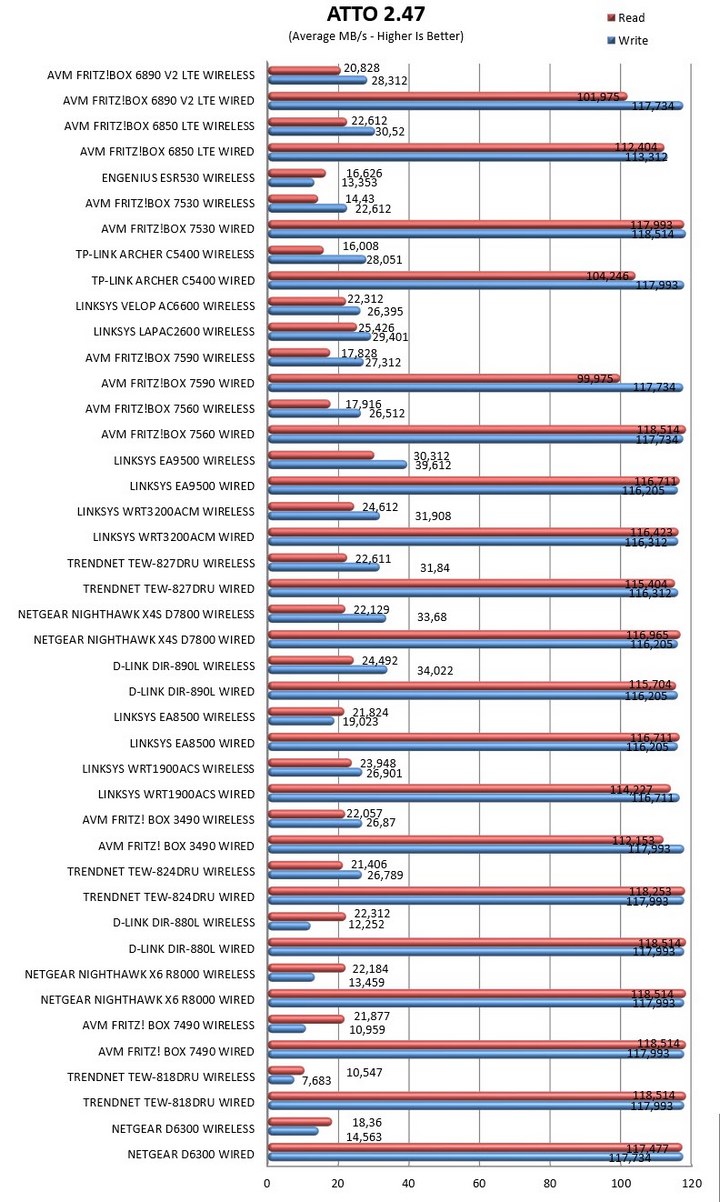

 INTERNET SPEED
INTERNET SPEED

USB

POWER CONSUMPTION

CONCLUSION
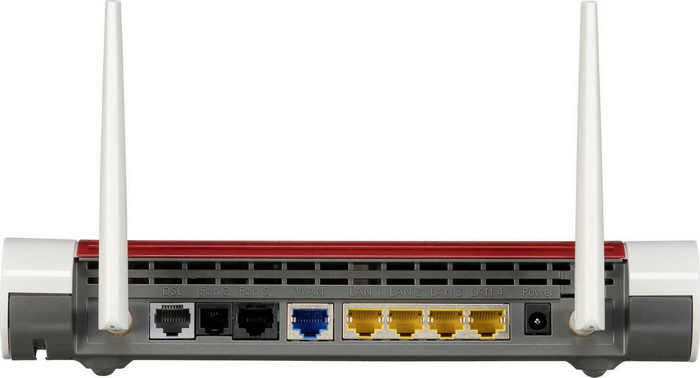
Aside the somewhat strange number I got while testing its 4G performance in Fast.com (which could had been due to one of the servers) the FRITZ!Box 6890 LTE v2 by AVM passed all my tests with flying colors. Of course, this was expected since as you’ve already seen from its interior shots it shares many components with the 7590 model which has been one of the best DSL/VDSL modem routers I’ve ever used. Power consumption is considerably higher compared to that of the 6850 model but again one supports landline and 4G connectivity whereas the other supports just the latter so that too was expected. Honestly there’s nothing I can think about the 6890 model that I didn’t like. One thing I did notice (just like with the FRITZ!Box 7590) was that the connected repeater I have next room (FRITZ!Repeater 2400) would lose its internet connection from time to time (not its connection to the 7590/6890) but I am not really certain whether or not the modem routers or the repeater itself is to blame.
The international version of the FRITZ!Box 6890 LTE v2 Modem Router by AVM retails for 349Euros inside the EU (Amazon.de) a price tag which is indeed not what many people would call affordable. Still AVM has always prioritized build quality, performance and number of features and you’re getting all of these and then some with the FRITZ!Box 6890 LTE v2 and that’s why it deserves the Golden Award.

PROS
- AC2533 WiFi 5 Technology (Concurrent 802.11n 2.4GHz & 802.11ac 5GHz Signals)
- Internet Compatibility (DSL/VDSL/4G LTE/3G UMTS/HSPA+)
- Available Features (MESH/NAS Server/Media Server/Answering Machine/DECT Station/IP Telephony)
- Overwhelming Number Of Available Settings/Functions
- Android & iOS Apps
- USB 3.0 Port
- 4 Gigabit Ethernet Ports (5 Including WAN)
- 5 Year Warranty
CONS
- WLAN Performance
- Price (For Some)

 O-Sense
O-Sense





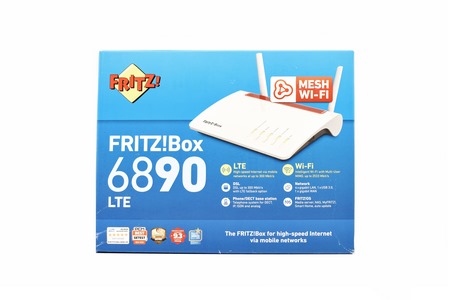










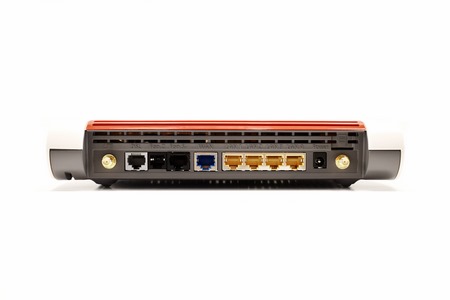
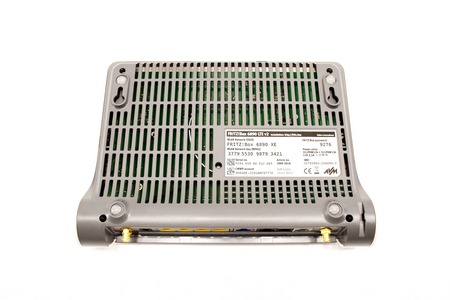
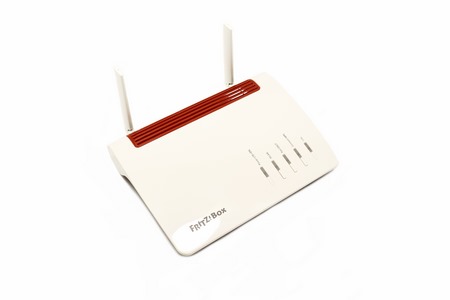

























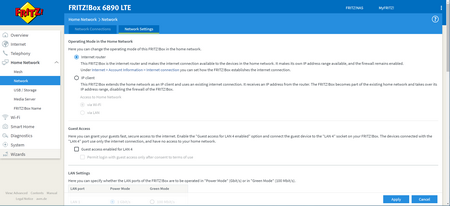













.png)

